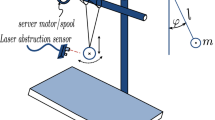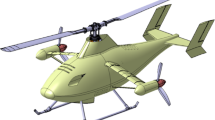Abstract
Gantry cranes have attracted extensive attention that are mostly simplified as nonlinear single pendulum systems without load hoisting/lowering. However, due to the existence of the hook in practice, gantry cranes produce double pendulum effect. With an extra underactuated degree of freedom, the anti-swing control of double pendulum gantry cranes becomes more difficult than that of single pendulum gantry cranes. Moreover, double pendulum gantry cranes with load hoisting/lowering may cause large swings, which lead to inaccurate positioning and low transportation efficiency. In this paper, a novel nonlinear coupled tracking anti-swing controller is proposed to solve these problems. The proposed controller can ensure the stable startup and operation of the trolley by introducing a smooth expected trajectory. In addition, a composite signal is constructed to suppress and eliminate the swing angles of the gantry crane system. The system stability is analyzed by utilizing Lyapunov techniques and Barbalat’s lemma. Theoretical derivation, simulation and experimental results indicate that the proposed controller suppresses and eliminates the hook/load swing angle effectively. Furthermore, it can achieve superior control effects and strong robustness against the changes of the load mass, trolley target displacement, initial rope lengths, initial system swing angles and external disturbances.











Similar content being viewed by others
Data availability
The datasets generated during and/or analyzed during the current study are available from the corresponding author on reasonable request.
Change history
09 May 2022
A Correction to this paper has been published: https://doi.org/10.1007/s11071-022-07470-y
References
Shi, H., Li, G., Ma, X., Sun, J.: Research on nonlinear coupling anti-swing control method of double pendulum gantry crane based on improved energy. Symmetry 11(12), 1511 (2019)
Sun, N., Zhang, J., Xin, X., Yang, T., Fang, Y.: Nonlinear output feedback control of flexible rope crane systems with state constraints. IEEE Access 7, 136193–136202 (2019)
Shi, H., Li, G., Bai, X., Huang, J.: Research on nonlinear control method of underactuated gantry crane based on machine vision positioning. Symmetry 11(8), 987 (2019)
Zhang, M., Ma, X., Rong, X., Sun, R., Tian, X.: Modeling and energy-based fuzzy controlling for underactuated overhead cranes with load transferring, lowering, and persistent external disturbances. Adv. Mech. Eng. 9(10), 1–13 (2017)
Lu, B., Fang, Y., Sun, N.: Enhanced-coupling adaptive control for double-pendulum overhead cranes with payload hoisting and lowering. Automatica 101, 241–251 (2017)
Xia, X., Wu, Z.: Optimal motion planning for overhead cranes. IET Control Theory Appl. 8(17), 1833–1842 (2014)
Sun, N., Fang, Y., Chen, H.: A new anti-swing control method for underactuated cranes with unmodeled uncertainties: theoretical design and hardware experiments. IEEE Trans. Ind. Electron. 62(1), 453–465 (2015)
Sun, N., Fang, Y., Chen, H., He, B.: Adaptive nonlinear crane control with load hoisting/lowering and unknown parameters: design and experiments. IEEE/ASME Trans. Mechatron. 20(5), 2107–2119 (2015)
Vazquez, Z., Collado, J., Fridman, L.: Control of a parametrically excited crane: a vector Lyapunov approach. IEEE Trans. Control Syst. Technol. 21(6), 2332–2340 (2013)
Boschetti, G., Caracciolo, R., Richiedei, D., Trevisani, A.: A non-time based controller for load swing damping and path-tracking in robotic cranes. Intell. Robot. Syst. 76(2), 201–217 (2014)
Lee, L., Huang, C., Ku, S., Yang, Z., Chang, C.: Efficient visual feedback method to control a three-dimensional overhead crane. IEEE Trans. Ind. Electron. 61(8), 4073–4083 (2014)
Masoud, Z., Alhazza, K., Abu-Nada, E., Majeed, M.: A hybrid command-shaper for double-pendulum overhead cranes. Vib. Control. 20(1), 24–37 (2014)
Tuan, L., Lee, S.: Sliding mode controls of double-pendulum crane systems. Mech. Sci. Technol. 27(6), 1863–1873 (2013)
Sun, N., Fang, Y., Chen, H., Fu, Y.: Super-twisting-based anti-swing control for underactuated double pendulum cranes. IEEE/ASME Int. Conf. Adv. Intell. Mechatron. 749–754 (2015)
Qian, D., Tong, S., Yang, B., Lee, S.: Design of simultaneous input-shaping-based SIRMs fuzzy control for double-pendulum-type overhead cranes. Bull. Polish Acad. Sci. Tech. Sci. 63(4), 887–896 (2015)
Chen, H., Fang, Y., Sun, N.: A swing constrained time-optimal trajectory planning strategy for double pendulum crane systems. Nonlinear Dyn. 89(2), 1513–1524 (2017)
Sun, N., Wu, Y., Chen, H., Fang, Y.: An energy-optimal solution for transportation control of cranes with double pendulum dynamics: design and experiments. Mech. Syst. Signal Process. 102(MAR.1), 87–101 (2018)
Zhang, M., Ma, X., Chai, H., Rong, X., Tian, X., Li, Y.: A novel online motion planning method for double-pendulum overhead cranes. Nonlinear Dyn. 85(2), 1079–1090 (2016)
Sun, N., Fang, Y., Chen, H., Lu, B.: Amplitude-saturated nonlinear output feedback anti-swing control for underactuated cranes with double-pendulum cargo dynamics. IEEE Trans. Industr Inform. 64(3), 2135–2146 (2017)
Zhang, M., Ma, X., Rong, X., Song, R., Tian, X., Li, Y.: A partially saturated adaptive learning controller for overhead cranes with payload hoisting/lowering and unknown parameters. Nonlinear Dyn. 89(2), 1779–1791 (2017)
Sun, N., Fang, Y.: Nonlinear tracking control of underactuated cranes with load transferring and lowering: theory and experimentation. Automatica 50(9), 2350–2357 (2014)
Huang, J., Liang, Z., Zang, Q.: Dynamics and swing control of double-pendulum bridge cranes with distributed-mass beams. Mech. Syst. Signal Process. 54–55, 357–366 (2015)
Masoud, Z., Alhazza, K., Abu-Nada, E., Majeed, m.: A hybrid command-shaper for double- pendulum overhead cranes. J. Vib. Control. 20(1), 24–37 (2014)
Manning, R., Clement, J., Kim, D., Singhose, W.: Dynamics and control of bridge cranes transporting distributed-mass payloads. J. Dyn. Syst. Meas. Control. 132(1), 1–8 (2010)
Sun, N., Yang, T., Fang, Y.: Transportation control of double-pendulum cranes with a nonlinear quasi-PID scheme: design and experiments. IEEE Trans. Syst. Man Cybern. Syst. 49(7), 1408–1418 (2019)
Sun, N., Wu, Y., Fang, Y.: Nonlinear anti-swing control for crane systems with double-pendulum swing eects and uncertain parameters: design and experiments. IEEE Trans. Autom. Sci. Eng. 15, 1413–1422 (2018)
Zhang, M., Ma, X., Rong, X.: A novel energy-coupling-based control method for double-pendulum overhead cranes with initial control force constraint. Adv. Mech. Eng. 10(1), 168781401775221 (2018)
Zhang, M., Zhang, Y., Cheng, X.: An enhanced coupling PD with sliding mode control method for underactuated double-pendulum overhead crane systems. Int. J. Control Autom. Syst. 17, 1579–1588 (2019)
Tuan, L., Lee, S., Ko, D., Nho, L.: Combined control with sliding mode and partial feedback linearization for 3D overhead cranes. Int. J. Robust Nonlinear Control 24(18), 3372–3386 (2014)
Chwa, D.: Sliding-mode-control-based robust finite-time antisway tracking control of 3-D overhead cranes. IEEE Trans. Ind. Electron. 64(8), 6775–6784 (2017)
Zhang, M., Zhang, Y., Ouyang, H., Ma, C., Cheng, X.: Adaptive integral sliding mode control with payload sway reduction for 4-DOF tower crane systems. Nonlinear Dyn. 99(7), 2727–2741 (2020)
Zhang, M., Ma, X., Rong, X., Song, R., Tian, X., Li, B.: A partially saturated adaptive learning controller for overhead cranes with payload hoisting/lowering and unknown parameters. Nonlinear Dyn. 89(2), 1779–1791 (2017)
Khalil, H.: Nonlinear Systems, 3rd edn. Prentice-Hall, Englewood Cliffs (2002)
Acknowledgements
This research has been supported in part by the National Natural Science Foundation of China (51905357, 52005352 and 52075348), in part by the Key Science and Technology Research Project of Shenyang (20-202-4-40) and in part by the Key Innovate R &D Program of Shenyang (Y19-1-004).
Author information
Authors and Affiliations
Corresponding author
Ethics declarations
Conflicts of interest
The authors declare that they have no conflict of interest.
Additional information
Publisher's Note
Springer Nature remains neutral with regard to jurisdictional claims in published maps and institutional affiliations.
Rights and permissions
About this article
Cite this article
Shi, H., Yao, F., Yuan, Z. et al. Research on nonlinear coupled tracking controller for double pendulum gantry cranes with load hoisting/lowering. Nonlinear Dyn 108, 223–238 (2022). https://doi.org/10.1007/s11071-021-07185-6
Received:
Accepted:
Published:
Issue Date:
DOI: https://doi.org/10.1007/s11071-021-07185-6




